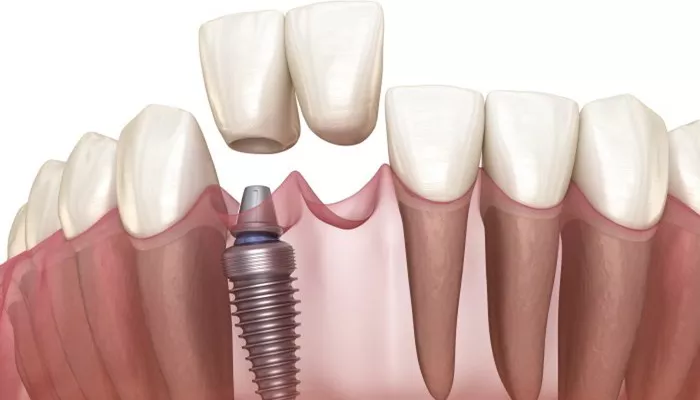Dental implants have become an increasingly popular solution for replacing missing teeth. They offer a natural-looking and long-lasting alternative to traditional dentures or bridges. If you’re considering dental implants, it’s important to understand the process and what to expect during the procedure. In this article, we’ll guide you through the step-by-step process of how dental implants are implanted.
How Is A Dental Implant Placed: A Step-by-Step Guide
1. Initial Consultation and Evaluation
The first step in the dental implant process is an initial consultation with your dentist or oral surgeon. During this appointment, they will thoroughly examine your mouth, take X-rays, and assess the condition of your jawbone. This evaluation helps determine if you are a suitable candidate for dental implants and if any additional procedures, such as bone grafting, are necessary.
Your dentist will also discuss your treatment plan, including the number of implants needed and the type of restoration (e.g., crown, bridge, or denture) that will be placed on top of the implants. It’s important to discuss your goals, expectations, and any concerns you may have during this consultation.
2. Tooth Extraction and Bone Grafting (if needed)
If you still have a damaged or decayed tooth that needs to be replaced, your dentist will extract it before proceeding with the implant placement. In some cases, a bone graft may be necessary to ensure that there is sufficient bone volume to support the implant. Bone grafting involves adding bone material to the area where the implant will be placed to stimulate new bone growth and provide a solid foundation for the implant.
After the tooth extraction and/or bone grafting procedure, you will need to allow several months for the area to heal and for the new bone to form. During this time, your dentist may place a temporary denture or bridge to restore your smile and chewing function.
SEE ALSO: How Much Is A Dental Implant in Chicago?
3. Implant Placement
Once the area has healed and sufficient bone has formed, your dentist will proceed with the implant placement surgery.
This is typically done under local anesthesia, and you may also be given sedation or general anesthesia depending on the complexity of the procedure.
During the surgery, your dentist will make an incision in the gum to expose the underlying bone. They will then use specialized tools to create a small hole in the bone, where the titanium implant post will be placed. The implant post is designed to mimic the root of a natural tooth and serves as the foundation for the artificial tooth that will be placed on top.
After the implant post is securely in place, your dentist will close the gum around it, leaving a small portion of the post exposed. In some cases, a temporary crown may be placed on top of the implant post to protect it during the healing process.
4. Osseointegration and Healing
The next step in the dental implant process is known as osseointegration, which is the process of the implant fusing with the surrounding bone. This process can take several months, depending on the individual’s healing ability and the location of the implant in the mouth.
During this time, you will need to be careful with your diet and oral hygiene to ensure proper healing. Your dentist may recommend a soft food diet and provide you with specific instructions on how to clean the area around the implant.
5. Abutment Placement
Once the implant has fully integrated with the bone, your dentist will place an abutment on top of the implant post. The abutment is a small connector piece that will support the artificial tooth or crown. Your dentist may need to make a small incision in the gum to expose the implant post and attach the abutment.
After the abutment is in place, your gums will need to heal for a couple of weeks before the artificial tooth can be attached.
During this time, your dentist may place a temporary crown or denture to protect the abutment and maintain your smile’s appearance.
6. Artificial Tooth Placement
The final step in the dental implant process is the placement of the artificial tooth or crown. Your dentist will take impressions of your mouth and send them to a dental laboratory, where a custom-made crown will be fabricated to match the color and shape of your natural teeth.
Once the crown is ready, your dentist will securely attach it to the abutment. The crown is designed to be durable and long-lasting, and it should function just like a natural tooth.
Aftercare And Maintenance
After your dental implant procedure is complete, it’s important to maintain good oral hygiene habits to ensure the longevity of your implant. This includes brushing and flossing regularly, using an antibacterial mouthwash, and attending regular dental check-ups and cleanings.
Your dentist may also recommend using a soft-bristled toothbrush and avoiding hard or crunchy foods that could damage the implant. With proper care and maintenance, dental implants can last for many years and provide you with a beautiful, functional smile.
Conclusion
Dental implants are a reliable and effective solution for replacing missing teeth. While the process may seem daunting, it’s important to remember that each step is designed to ensure the success and longevity of your implant. By working closely with your dentist and following their instructions, you can achieve a beautiful, healthy smile that will last for years to come.
Related topics:

